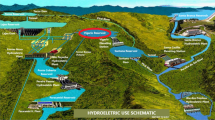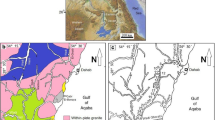Abstract
The main geochemical characteristics of gray silts of the Volga Reservoir cascade are discussed. Together with sandy varieties, they occupy more than 60% of the total bottom area in some reservoirs. Gray silt samples were taken in the first half of June 2016 during an expedition from the Borok Port to the Astrakhan Port on the R/V Akademik Topchiev. It is shown that the content of Ni, Cr, Y, and Sr in gray silts increases from the Rybinsk Reservoir to the Kuibyshev Reservoir, and gradually decreases downstream. On the contrary, the Ba and Zn contents remain almost unchanged downstream the reservoir cascade. Values of a number of indicator ratios (Cr/Th, Th/Sc, and others) behave approximately the same way. In general, the content of trace elements in the studied gray silt samples is lower than in the Post-Archean Australian Shale (PAAS). Hence, the grain size composition of gray silts and the PAAS is most likely somewhat different because of certain diluting effect of the nonclay component. Gray silts sampled from the Kama River mouth opposite the Atabaevo Settlement (station 39) are characterized by a significantly lower (La/Yb)N value than other samples studied in this work, indicating a fundamentally different (probably, Uralian?) source of the aluminosiliciclastic material in this sample.









Similar content being viewed by others
Notes
In accordance with concepts in monograph (Zagryaznyayuschie veschestva …, 2017) and taking into consideration the administrative regionalization of the Upper Volga (UV) River basin, the UV basin extends from its sources to the Gorky Reservoir and the Oka River basin. The Middle Volga basin includes the catchment area downstream from the Gorky Reservoir to the Kuibyshev HEP site (including the Chebokasary Reservoir and Kama River basin). The Lower Volga basin includes the Saratov and Volgograd reservoirs, Volga-Akhtuba floodplain and Volga delta.
Water discharge into the lower reaches of reservoirs provokes a significant change in the rate and level of flows, erosion of river bed and banks, as well as transport of terrigenous particulates into the main water area. In some places, the amount of autochthonous particulates produced by the washout of river bed in shallow sectors can be comparable with (and sometimes even exceed) the amount of material transported to the reservoir during the bank abrasion (Butorin et al., 1975).
According to (Zakonnov et al., 2007), these sediments are represented mainly by the clayey–sandy silts.
Note that the Cr content varies markedly in works of different researchers: for example, the BS content in the Kuibyshev Reservoir is ~85 ppm according to (Ekologicheski bezopasnoe ……, 2008), and just 59 ppm, according to (Tomilina et al., 2018).
It is believed that the value Cr/Ni > 2.0 suggests a significant transformation of the fine-grained ultramafic terrigenous particulates during the transport (Garver et al., 1996).
Note that this content is given most likely for the “BS in general,” since the above-cited work suggests: “The surficial BS layer was taken with three replications. The column height reached 7–10 cm. The central sample was mixed thoroughly. Then, large pebbles, plant remnants, and living and dead mussels were removed…”.
REFERENCES
Bayon, G., Toucanne, S., Skonieczny, C., et al., Rare earth elements and neodymium isotopes in world river sediments revisited, Geochim. Cosmochim. Acta, 2015, vol. 170, pp. 17–38.
Bezrukov, P.L. and Lisitsyn, A.P., Classification of sediments in modern marine basins, in Geologicheskie issledovaniya v dal’nevostochnykh moryakh (Geological Studies in Far East Seas), Bezrukov, P.L., Ed., Moscow: AN SSSR, 1960.
Braccialli, L., Marroni, M., Pandolfi, L., and Rocchi, S., Geochemistry and petrography of Western Tethys Cretaceous sedimentary covers (Corsica and Northern Apennines): from source areas to configuration of margins, in Sedimentary Provenance and Petrogenesis: Perspectives from Petrography and Geochemistry, Arribas, J., Critelli, S., and Johnsson, M.J., Eds., Geol. Soc. Am. Spec. Pap., 2007, no. 420, pp. 73–93.
Brekhovskikh, V.F., Katunin, D.N., Ostrovskaya, E.V., et al., Heavy metal transportation and accumulation processes in the Lower Volga River, Water Resour., 1999, vol. 26, no. 4, pp. 400–410.
Brekhovskikh, V.F., Volkova, Z.V., Katunin, D.N., et al., Heavy metals in bottom sediment in the Upper and Lower Volga, Water Resour., 2002, vol. 29, no. 5, pp. 539–547.
Butorin, N.V., Ziminova, N.A., and Kurdin, V.P., Donnye otlozheniya verkhnevolzhskikh vodokhranilishch (Bottom Sediments in Upper Volga Reservoirs), Leningrad: Nauka, 1975.
Condie, K.C., Chemical composition and evolution of the upper continental crust: contrasting results from surface samples and shales, Chem. Geol., 1993, vol. 104, pp. 1–37.
Condie, K.C. and Wronkiewicz, D.A., The Cr/Th ratio in Precambrian pelites from the Kaapvaal Craton as an index of craton evolution, Earth Planet. Sci. Lett., 1990, vol. 97, pp. 256–267.
Cullers, R.L., Implications of elemental concentrations for provenance, redox conditions, and metamorphic studies of shales and limestones near Pueblo, CO, USA, Chem. Geol., 2002, vol. 191, pp. 305–327.
Denisova, A.I., Nakhshina, E.P., Novikov, B.I., and Ryabov, V.K., Donnye otlozheniya vodokhranilishch i ikh vliyanie na kachestvo vody (Bottom Sediments in Reservoirs and Their Influence on Water Quality), Kiev: Nauk. Dumka, 1987.
Ekologicheski bezopasnoe, ustoichivoe razvitie basseina Volgi. Aspekty mezhdunarodnogo nauchnogo sotrudnichestva (Ecologically Safe and Persistent Development of the Volga Basin: Aspects of International Scientific Cooperation), Novgorod: NNGASU, 2008, p. 178.
Garver, J.I., Royce, P.R., and Smick, T.A., Chromium and nickel in shale of the Taconic foreland: a case study for the provenance of fine-grained sediments with an ultramafic source, J. Sedim. Res., 1996, vol. 66, pp. 100–106.
Gavrilov, Yu.O., Shchepetova, E.V., Rogov, M.A., and Shcherbinina, E.A., Sedimentology, geochemistry, and biota of Volgian carbonaceous sequences in the northern part of the Central Russian Sea, Kostroma region). Lithol. Miner. Resour., 2008, no. 4, pp. 354–379.
Geologicheskaya karta SSSR. Masshtab 1 : 1 000 000 (novaya seriya). List M-(38), (39)—Ural’sk. Ob"yasnitel’naya zapiska (Geological Map of the Soviet Union. Scale 1 : 1 000 000 (New Series). Sheets M-38, M-39), Leningrad: MinGeo SSSR, 1988.
Geologiya SSSR (Geology of the Soviet Union), Moscow: Nedra, 1967, vol. 11 (Volga and Kama Regions, part 1 (Geological Description).
Gordeev, V.V., Rechnoi stok v okean i cherty ego geokhimii (River Discharge into Ocean and Geochemistry), Moscow: Nauka, 1983.
Gosudarstvennaya geologicheskaya karta Rossiiskoi Federatsii. Masshtab 1 : 1 000 000 (novaya seriya). List O-(38), (39)— Kirov. Ob"yasnitel’naya zapiska (State Geological Map of the Russian Federation. Scale 1 : 1 000 000. Sheets O-38, O-39 (Kirov Region), Explanatory Note), St. Petersburg: VSEGEI, 1999.
Gosudarstvennaya geologicheskaya karta Rossiiskoi Federatsii. Masshtab 1 : 1 000 000 (tret’e pokolenie). List O-37 (Yaroslavl’). Ob"yasnitel’naya zapiska (State Geological Map of the Russian Federation. Scale 1 : 1 000 000. Sheet O-37 (Yaroslavl Region), Explanatory Note), St. Petersburg: VSEGEI, 2015.
Karnaukhova, G.A., Lithological–geochemical differentiation of bottom deposits in the Angara cascade reservoirs, Geochem. Int., 2007, no. 4, pp. 390–398.
Karnaukhova, G.A., Belt zoning of sedimentation in the Angara cascade reservoirs, Geochem. Int., 2011, no. 6, pp. 605–617.
Kasimov, N.S., Ekogeokhimiya landshaftov (Ecogeochemistry of Landscapes), Moscow, 2013.
Lychagin, M.Yu., Kasimov, N.S., Kur’yakova, A.N., and Kroonenberg, S.B., Geochemical peculiarities of water topography in the Volga delta, Izv. Akad. Nauk, Ser. Geogr., 2011, no. 1, pp. 100–113.
Maslov, A.V., Krupenin, M.T., and Kiseleva, D.V., Lithogeochemistry of the fine-grained siliciclastic rocks of the Vendian Serebryanka Group of the Central Urals, Geochem. Int., 2011, no. 10, pp. 974–1001.
Maslov, A.V., Kozina, N.V., Klyuvitkin, A.A., et al., Rare-earth element distribution and 87Sr/86Sr systematics in modern bottom sediments of the Caspian Sea, Dokl. Earth Sci., 2014a, vol. 459, no. 2, 1418–1423.
Maslov, A.V., Shevchenko, V.P., Podkovyrov, V.N., et al., Specific features of the distribution of trace and rare earth elements in recent bottom sediments in the lower course of the Severnaya Dvina River and White Sea, Lithol. Miner. Resour., 2014b, no. 6, pp. 433–460.
Maslov, A.V., Kozina, N.V., Shevchenko, V.P., et al., REE systematics in modern bottom sediments of the Caspian Sea and river deltas worldwide: Experience of comparison, Dokl. Earth Sci, 2017, vol. 475, no. 1, pp. 797–802.
Maslov, A.V., Kuznetsov, A.B., Politova, N.V., et al., Distribution of trace and rare-earth elements, and Nd, Pb, and Sr isotopes in the surface Sediments of the Barents Sea, Geochem. Int., 2020a, vol. 65, no. 6, pp. 687–703.
Maslov, A.V., Mel’nichuk, O.Yu., Mizens, G.A., et al., Reconstruction of rock composition in provenances: Communication 2. Litho- and isotope geochemical approaches and methods, Litosfera, 2020b, vol. 20, no. 1, pp. 40–62.
Maslov, A.V., Politova, N.V., Kozina, N.V., et al., Rare and trace elements in the modern bottom sediments of the Barents Sea, Lithol. Miner. Resour., 2020c, no. 1, pp. 1–23.
Migdisov, A.A., Balashov, Yu.A., Sharkov, I.V., et al., Distribution of rare earth elements and main lithological types of rocks in the sedimentary cover of the Russian Platform, Geokhimiya, 1994, no. 6, pp. 790–803.
Nemirovskaya, I.A. and Ostrovskaya, E.V., Monitoring of organic compounds in the Volga catchment area, PEMME, 2018.
Nemirovskaya, I.A., What is going on in the Volga River?, Priroda, 2018, no. 2, pp. 45–53.
Ob”yasnitel’naya zapiska k komplektu geologicheskikh kart masshtaba 1 : 1 000 000. List L-(38), (39)—Astrakhan (Explanatory Note to Geological Maps. Scale 1 ; 1 000 000. Sheets L-38, L-39 (Astrakhan), St. Petersburg: VSEGEI, 1996.
Ottenstein, R., Investigation of the Volga River sediments composition. Inorganic pollutants of potential concern, Abstract of the PhD Dissertation, Heidelberg: Ruprecht-Karls-Univ., 2005.
Taylor, S.R. and McLennan, S.M., The Continental Crust: Its Composition and Evolution, Oxford: Blackwell, 1985.
Tikhomirov, O.A. and Markov, M.V., Accumulation of heavy metals in bottom sediments of water compounds in the reservoirs of the seasonal discharge regulation, Uchenye Zapiski Kazanskogo gosudarstvennogo universiteta (Scientific Notes of the Kazan Sate University), 2009, vol. 151.
Tkachenko, A.N., Geochemistry of water topography in the Volga estuary, Abstract of the PhD (Geogr.) Dissertation, Moscow: MGU, 2011, vol. 81, no. 84, pp. 107–131.
Tomilina, I.I., Gapeeva, M.V., and Lozhkina, R.A., Assessment of the quality of water and bottom sediments in the reservoir cascade of the Volga River based on indicators of toxicity and chemical composition, Tr. IBVV RAN, 2018, no. 81, pp. 107–131.
Volga—glavnaya ulitsa Rossii. Proekt Russkogo geograficheskogo obshchestva (Volga—Main River of Russia: Project of the Russian Geographic Society), Moscow: RGO, 2012.
Yan, B., Yan, W., Miao, L., et al., Geochemical characteristics and provenance implication of rare earth elements in surface sediments from bays along Guangdong Coast, South-East China, Environ. Earth. Sci., 2012, vol. 65, no. 7, pp. 2195–2205.
Zagryaznyayushchie veshchestva v vodakh Volzhsko-Kaspiiskogo basseina (Pollutants in the Volga–Caspian Basin Waters), Astrakhan, 2017.
Zakonnov, V.V., Sedimentation in waters of the Volga reservoir cascade, Abstract of the DSc (Geogr.) Dissertation, Moscow: IBVV RAN, 2007.
Zakonnov, V.V., Ivanov, D.V., Zakonnova, A.V., et al., Spatial and temporal transformations of bottom sediments in the Middle Volga reservoirs, Water Resour., 2007, vol. 34, no. 5, pp. 540–548.
Zakonnov, V.V., Poddubnyi, S.A., Zakonnova, A.V., and Kas’yanova, V.V., Sedimentation in variable-backwater zones of Volga chain reservoirs, Water Resour., 2010, vol. 37, no. 4, pp. 462–470.
Zakonnov, V.V., Mud accumulation in the Volga reservoir cascade, Trudy IBVV RAN, 2016, no. 75, pp. 30–40.
ACKNOWLEDGMENTS
The authors are grateful to the crew of R/V Akademik Topchiev, V.V. Zakonnov for help in the collection of samples, and N.S. Glushkova (Institute of Geology and Geochemistry, Ural Branch) for the layout of graphic materials in this paper.
Funding
The collection of samples and their preliminary processing were supported by the Russian Science Foundation (project no. 14-27-00114). Interpretation of the results was accomplished under State Task of the Shirshov Institute of Oceanology, Russian Academy of Sciences (registration no. 0128-2021-0016) and the Geological Institute, Russian Academy of Sciences.
Author information
Authors and Affiliations
Corresponding authors
Additional information
Translated by D. Sakya
Rights and permissions
About this article
Cite this article
Maslov, A.V., Nemirovskaya, I.A. & Shevchenko, V.P. Gray Silts of the Volga Reservoir Cascade: Main Features of Geochemistry. Lithol Miner Resour 57, 181–198 (2022). https://doi.org/10.1134/S0024490222020055
Received:
Revised:
Accepted:
Published:
Issue Date:
DOI: https://doi.org/10.1134/S0024490222020055




